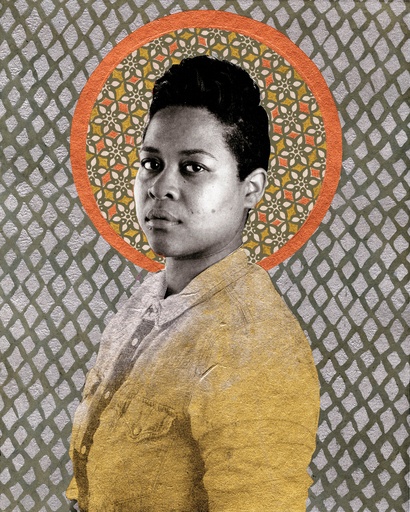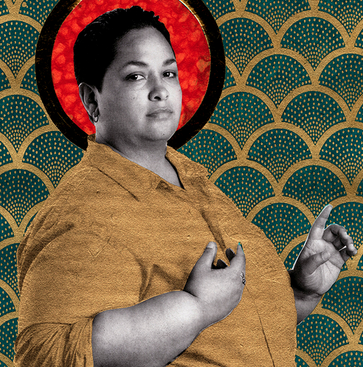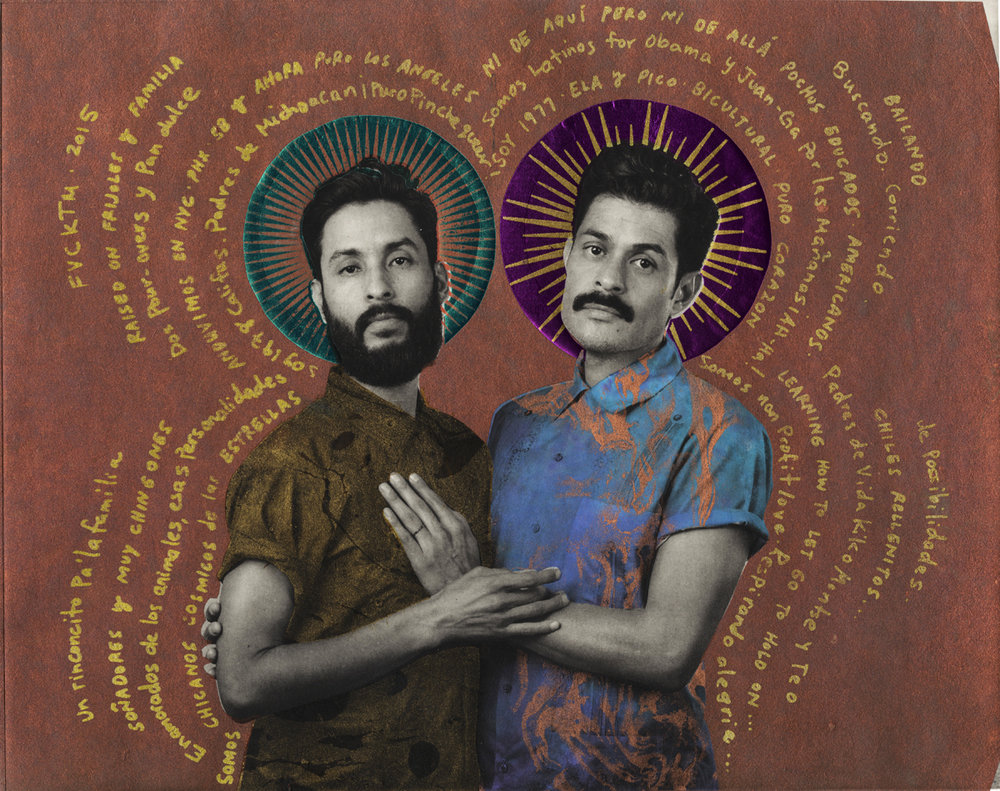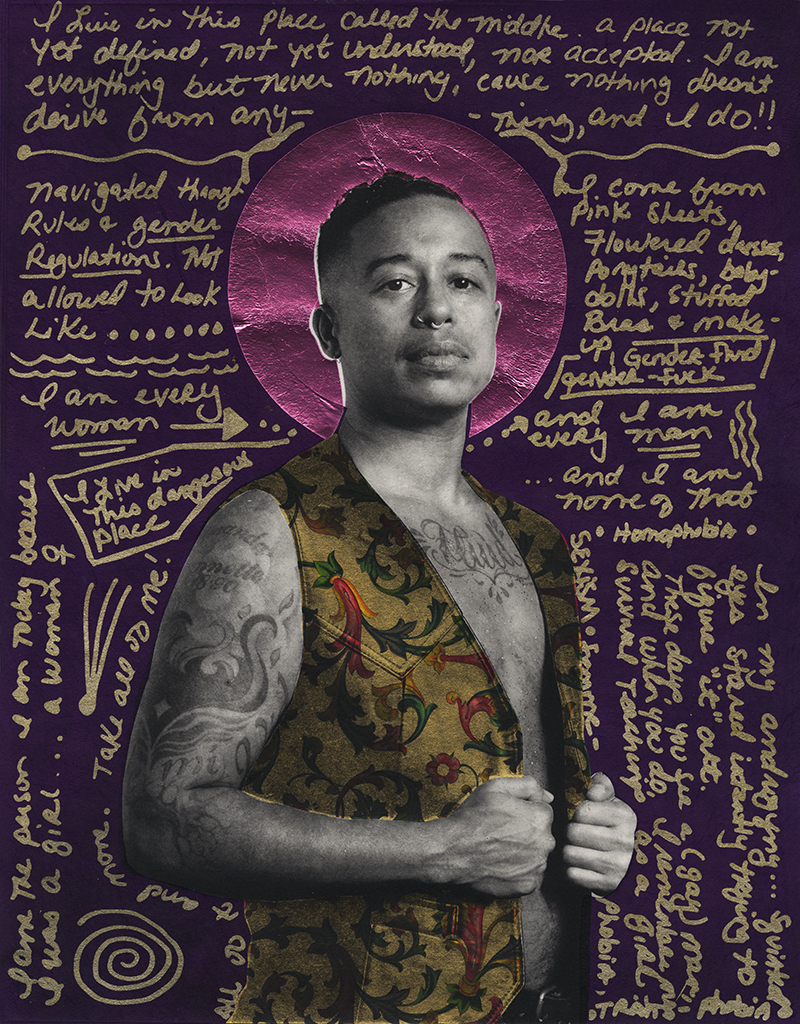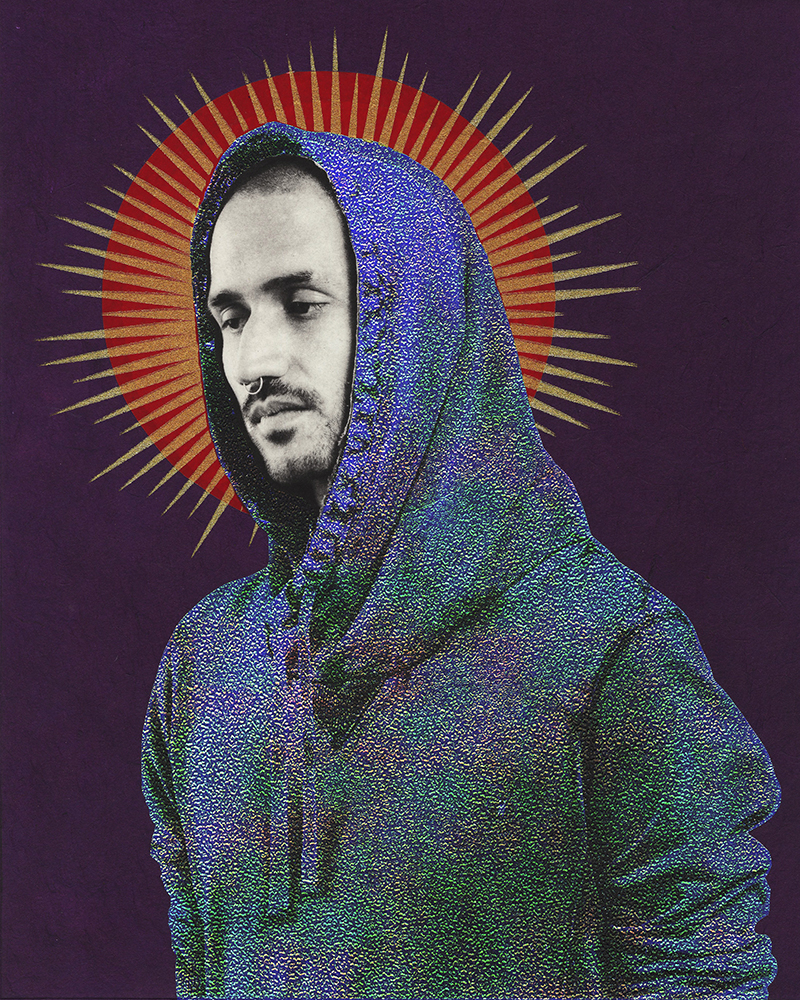Q&A: Gabriel Garcia Roman
By Hamidah Glasgow | October 27, 2017
The subjects in the series are drawn from many facets of the gender and queer spectrum, and these images give visibility to a population that’s generally under-represented in the art world. Finding inspiration in portraiture styles of Renaissance, Flemish and Christian Orthodox paintings, the series aims to elevate these multi-dimensional, powerful and proud contemporary figures. From the queer Latina fighting for immigration rights to the non-binary disabled Trans Filipino, the artist perceived these figures as heroes in their own right. Applying a chine-collé technique to the photogravure process, the artist transmutes his subjects into icons, dovetailing textured collage and photography into one-of-a-kind prints. Though the depth of light in the prints gets flattened in the process, this repositions the portrayed “outsiders” as central to the narrative, just like saints―figures that are inherently worthy of attention, emulation, and storytelling. Much like traditional religious paintings conferred a sense of safety and meditative calm on a home; the works in this series aspire to provide a similar sense of refuge that’s drawn from the inner grace of the subjects and projected outwards onto a world that might not always be safe.
Most recently, the artist has invited his subjects to partake in the creative process by contributing writings of their own. These handwritten texts end up being an essential part of the composition, surrounding the subjects with their musings, poems and affirmations. The inclusion of these texts confers upon the prints a depth that is at once aesthetic and, most importantly, psychological. Indeed, by screen printing the text around his subjects, he affords the viewer a glimpse into their mind and sensibilities, further reinforcing the centrality of their position in this series.
HG: Placing outsiders as central to the narrative are a way that I would describe one of the goals of our collective. This is also the primary element of your Queer Icons series. This work is so powerful, the first time I saw Sidra, I was immediately drawn in. How did you begin making this work?
GGR: I started this project out of a need for representation and celebration of the queer/trans community of color. I started the project in 2011, my final year of art school, marriage equality was a big news item, celebrities coming out of the closet and queer identity was becoming mainstream, but with all of these advancements it was becoming clear to me that I didn't see myself, my community represented in any of this. I decided that I would insert our community into this narrative. I was going to create a body of work that celebrated the QTPoC community. I was going to portray my subjects as noble, brave and regal beings. One of the first things that came to mind was to portray them as saints, having grown up
Catholic I gravitate towards religious art. I thought a saint is the epitome of a noble, regal and brave individual and that is when I started adding the halo to everybody that I included in the series.
HG: Yes, they are noble and regal beings. This celebration and deification of them are quite powerful. I realize that this is one of the reasons they touch me so dearly, to see the queer community in this light is affirming and right. Have you had any push back on this work? The Catholic Church isn’t known for its acceptance of LGBTQ folks.
GGR: Believe it or not I have not gotten any push back! When NPR wrote about the series, I figured that I'd get some hate mail or negative comments, but I was approached by a few queer Catholic organizations. They were excited about the work and wanted to include it in their literature. A curator interested in displaying my work at the Cathedral of St. John the Divine approached me last year. I had 12 framed prints front and center of the cathedral. It was quite a proud moment for me.
HG: What propelled you to add the element of text to the images?
GGR: One of the beauties of portraiture is that I as the viewer can create my own narrative when looking at a portrait. I can guess and make a story about the person based on their clothing, their posture, and facial expression. There's also a danger in that as well, specifically for this series as the point is to highlight and celebrate a community that is disenfranchised. The QTPoC community is already silenced enough through systematic racism, and I wanted to highlight or amplify their voice using their words. I decided that I wanted to collaborate with the sitter and have them chose how they want to be perceived in the world. I wanted them to use their words, their own hands to create that narrative for us. I wanted them to speak from the walls of these institutions. I wanted to make it as personal as possible and having them write their words with their own hands was important to me.
HG: Yes, this is a powerful way for them to be seen and heard. There are many layers of symbolism, texture, text, and color to each portrait as well as several versions of each portrait. I experience this as the manifestation of the complexity of queer life and for these particular people, the complexity of QTPoC. Is that an accurate reading?
GGR: Yes I wanted to highlight the complexity and depth of the QTPoC community. The many intersections that we have to navigate.
Haddie
HG: How do you find your subjects? Are they people that are already in your life or do you seek them out?
GGR: The initial start of the project included people already in my life and then I moved to friends of friends. As the project grew, I decided that I was going to hone in on a particular group from within the QTPoC community and so I start reaching out to activists, poets, and community organizers. I wanted to highlight members of the community that were doing something for the community as I see them as the modern-day saints. They are going above and beyond their call for the betterment of the community. I started reaching out to activists, community organizers, and poets that I would meet through social media or friends. At this point in the project, I either do a call out on my social media accounts for recommendations, and I choose based on that. Jamal, for example, is somebody I followed on Tumblr and Instagram. I was pulled in by their confidence and their politics, and so I reached out to them and was happy to know they were aware of my work and happy to participate.
HG: Haddies words, “Today I transcend. Today I live. I live with every formidable facet of my existence. The she, the brown, the queer. Today I'm not armed with the knowledge of which one, which part of my reality they'll attack with fake promises of heathenic cleansing, white-washed fairy tails or the key to being the good woman I have the potential to be. I transcend. I reminisce of the days I sought refuge in daddy's closet. Hoping my mother would recognize me when I came out. I live” speak to the angst and struggle of queer life while embracing the core of being human, which is to live fully. These collaborative portraits celebrate living and being alive. Have you thought about exhibiting them as an installation of shrines?
GGR: I have not thought about that but I did start making my own frames for the prints, and many of them are reminiscent of baroque and rococo frames. They are gilt in gold paint and lots of wood elements. I had a solo show at Gallery Aferro last year, and I decided that I wanted to paint the gallery walls an aqua blue color and display my prints lining both sides of the gallery. I wanted the viewers to feel as if they walked into a small church in Mexico.
HG: Can you talk about the process of working with your subjects to create the writings and the portraits?
GGR: I give the sitter free rein on the text, and the only thing I say is that they should write about their identity. It could be any part of their identity; them as a queer person, them as a person of color, them as an educator, a poet, etc. They could also be simple affirmations for themselves or the community. The rest is up to them; the format in which they lay out the text is theirs. The text you see is done in their own handwriting. Everybody has a distinct voice and handwriting, so I wanted to highlight that as well; their words their handwriting. The portraits are also a collaboration of sorts; I have a clear vision of how I want to portrait to look and so I'll guide my models with words or visual cues. I'll show them examples of some of my favorite portraits for reference, but they all bring their own element into the frame as well. I know that I want them to look strong, proud, royal, resilient and vulnerable as well.
Zach
HG: Tell me more about the hand gestures of the sitters?
GGR: I am a huge fan of Northern Renaissance artists like Jan Van Eyck, Rogier van der Weyden, and Albrecht Durer, a lot of that influence comes through in my portraiture. Stoic gaze, details in the folds and creases of the clothing and the soft and natural hand gestures. Personally speaking, I am fascinated by the human hand and like to include them in as many of my portraits as possible. Hands can tell you so much about a person. How well maintain their keep their nails, whether they bite their nails, do they choose to wear rings, paint their nails, or keep them natural.
HG: Where will this project go next? Are you still working on it?
GGR: Yes, I am still working on the project. It is a labor of love and don't see it coming to an end anytime soon. I am actually at the print shop working on the latest print as we speak. I like to push my projects and add new elements, right now I'm quite enamored with embroidery and think that will be the next step. Adding embroidered elements to the prints. I want them to feel like delicate relics. I also want to take this project global and travel to Latin America to photograph queer activists out there doing work.
HG: Would you like to share news about your work or upcoming exhibitions with our audience?
GGR: Well I am currently in an exhibition at Cassilhaus, in Durham, North Carolina. The exhibit runs til December. International Center of Photography just purchased two original Queer Icon prints, and so I'm quite proud of that! I am quite active in social media so you can follow me on Instagram or Facebook to keep up to date with any news or updates! @gbrlgrcrmn
I update my website regularly with any upcoming exhibitions.
HG: Thank you for your time and vision. We need this work to be seen and heard.


